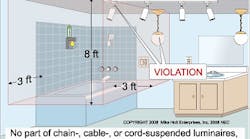All questions and answers are based on the 2008 NEC.
Q. What are the requirements for installing fixtures in a bathroom?
A. No part of chain-, cable-, or cord-suspended luminaires, track luminaires, or ceiling paddle fans can be located within 3 feet horizontally and 8 feet vertically from the top of the bathtub rim or shower stall threshold, as shown in Fig. 1.
Luminaires located within the actual outside dimensions of a bathtub or shower to a height of 8 feet from the top of the bathtub rim or shower threshold must be marked for damp locations. Where subject to shower spray, the luminaires must be marked for wet locations [410.10(D)], as shown in Fig. 2.
Q. What are the requirements for installing communications cable underground?
A. Communications systems aren’t subject to the general requirements of Chapters 1 through 4, or the special requirements of Chapters 5 through 7, unless there’s a specific reference in Chapter 8 to a rule in Chapters 1 through 7 [90.3]. The cover requirements contained in 300.5 don’t apply to communications wiring, because nothing in Chapter 8 references 300.5.
Q. Can a 3-pole breaker be used on a single-phase (2-wire) load in a 3-phase panel?
A. Yes. According the UL White Book (Product Category DIVQ), multipole common trip circuit breakers rated 120/240V are suitable for use for a single-phase, multiwire circuit, with or without the neutral connected to the load.
Note, if the system is a delta with a hi-leg, the slash (120/240V) breaker would not be acceptable due to the fact that the hi-leg to ground will be 208V, not 120V. They would have to be rated for 240V straight. This would include any overcurrent device connected to the hi-leg of the system.
Q. What are the requirements for the placement of general-purpose receptacles in nondwelling unit occupancies? Is it every 12 feet like dwelling units?
A. No. The NEC is not a design manual; therefore, it does not have any requirements for convenient receptacle placement in non-dwelling occupancies. This is all up to the designer.
Q. Is there a minimum and/or maximum height when installing circuit breakers?
A. There is no minimum height, except for manufactured homes [550.32(F)], which is 2 feet above grade. Circuit breakers must be installed so the center of the grip of the operating handle of the fuse switch or circuit breaker, when in its highest position, isn’t more than 6 feet 7 inches above the floor or working platform [240.24(A)].
Q. Is a warning ribbon required for underground service conductors if installed in a raceway?
A. No, only direct-buried service-lateral conductors not under the exclusive control of the electric utility [90.2(B)(5)] must have their location identified by a warning ribbon placed, in accordance with the requirements of 300.5(D).
Q. Is a warning ribbon required for service conductors installed by directional boring?
A. No.
Q. What is the minimum size feeder/service for a construction trailer panel that has three or more branch circuits?
A. The feeder/service conductors must have a rating not less than 60A [225.39(D) and 230.79(D)].
Q. Does the NEC limit voltage drop for parking lot lighting?
A. Maybe. Electrical equipment must be installed in accordance with manufacturer’s instructions, which typically indicate that the maximum voltage drop is limited to 10% of the luminaire voltage rating. Many believe that the Code requires conductor voltage drop to not exceed 3%, as per Fine Print Note (FPN) 4 of 210.19(A)(1). Although this is often a good practice, it’s not a Code requirement because FPNs are only advisory [90.5(C)].
However, ASHRAE 90.1 – 1999 Energy Code has a voltage drop requirement for all commercial buildings, which is similar as referenced in the FPNs in the NEC.




